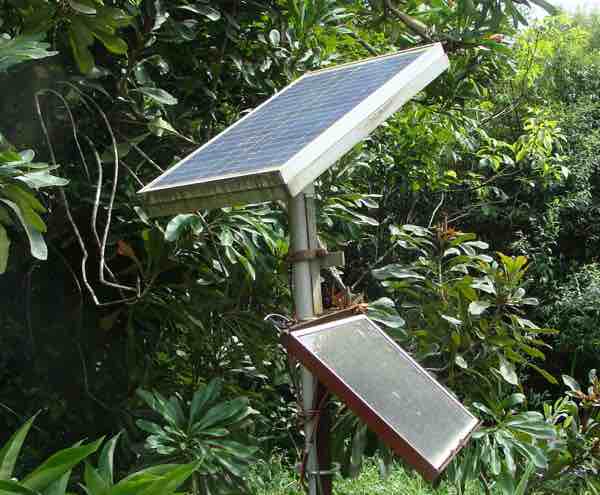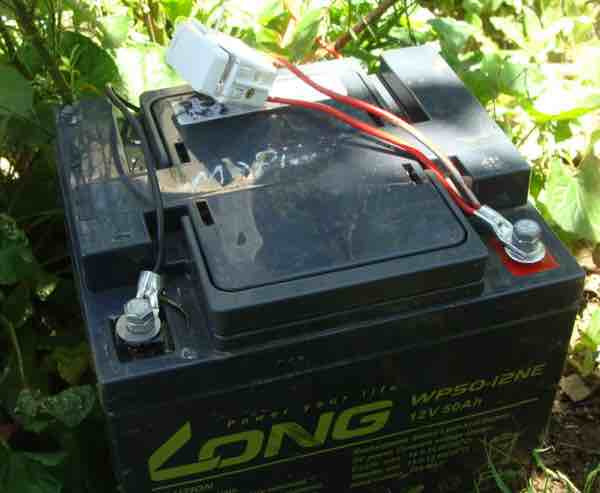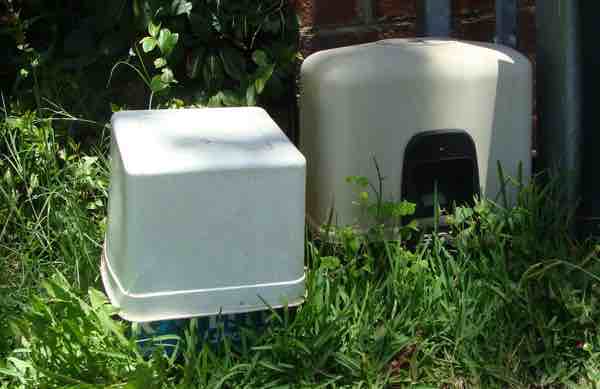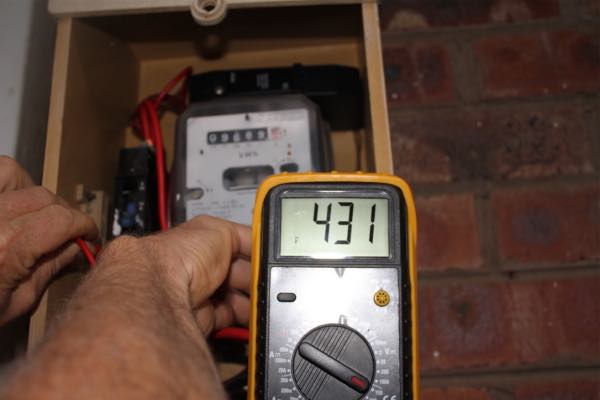- Bernard Preston homepage
- Solar geek
- Solar Gate Motor
Solar gate motor
A solar gate motor can be very simply charged by the sun at minimal expense; small PV panels can be used to supply a 12V-battery which then can power a low voltage DC appliance at any time of the day or night.
This really is a job for the DIY guy or girl. The big saving is that you will not need a qualified electrician to lay an armored high-voltage cable; build it yourself.
If your gate gets a lot of traffic two panels at right angles will make sure the battery remains fully charged.

This page was last updated by Bernard Preston on 3rd April, 2023.
- A 20 - 25W solar panel.
- A roughly 2m pole.
- A bracket to attach the panel to the pole; clamps.
- 1.5mm wiring.
- An inexpensive diode.
- A second hand 45 - 60Ah battery from your dealer.
- A switch.
- No expensive charge controller is needed for most gate motors.
Most gate motors use a small, roughly 10Ah gel cell battery which personally I find inadequate; they are neat because they fit snugly within the housing but just do not store enough energy to cope with inclement weather and overnight demand. They are also expensive and rarely last more than a year or two.
The 2.2m aluminium pole is what you probably still have lying around from an old TV aerial.
Those brackets for the panels are very easy to weld up from some scrap iron. Position them at around your angle of latitude; 30 degrees in my case.
So I recommend moving to a motorcycle or golf cart battery; 45Ah or more. Good second ones can often be picked up cheaply and they last because of the very low demand on them to drive the solar gate motor; they also love the slow trickle-charge from the small PV panels.
I say panels as in my experience it is best to have two, one facing basically east and the other west; 15 - 25 W each is ideal, depending on the number of times the gate must be opened and closed. Usually they are used most early and late in the day, so one north or south-facing PV is not ideal unless you have quite a large battery.
Start with one panel and if it is not adequate, it is simple to add another.
Ideally the PV panels should be identical, otherwise you will need to use an extra diode to prevent the one reversing the current in the other; as I have had to do above.
It is rather less tidy as the battery will not fit into the gate motor assembly. Covering it with an ice-cream container, for example protects it from the elements.
Classically one should use a regulator but in practice charging a larger battery with around 15W all day does no harm.
It is wise if concerned to look out for tell tale signs of overcharging; the battery becoming warm, the casing swelling or the terminals corroding badly.
That has never happened on the battery that I gleaned from a motorcycle; about 35 - 50 Ah is ideal.
The small gel-cell batteries certainly will need a regulator; they are quite unable to cope with being overcharged and one of the terminals will corrode and literally fall off. More recently small lithium batteries are available but very expensive.
At this stage because we have one of each, the wet battery that requires topping up periodically with distilled water and a sealed type, I am not certain which to recommend; both seem fine.
The wet, unsealed type we have had for over a year; it is actually a 35 Ah motorcycle battery, bought cheaply secondhand and is perfect; but it requires topping up every few months with distilled water.
The sealed battery from a golf cart I have had only for a few months; I am watching it carefully for signs of overcharging. It has been fine to date, so I think you can use either but I am not altogether certain.
Obviously sealed batteries require no maintenance; I watch with interest to see if it lasts as long, or like the gel cell batteries is not suitable for a solar gate motor.
Solar gate motor
Newsletter
Our newsletter is entitled "create a cyan zone" at your home, preserving both yourself and Mother Earth for future generations; and the family too, of course. We promise not to spam you with daily emails promoting various products. You may get an occasional nudge to buy one of my books.
Here are the back issues.
- Lifestyle and ideal body weight
- What are ultra-processed foods?
- Investing in long-term health
- Diseases from plastic exposure
- Intensive lifestyle management for obesity has limited value
- A world largely devoid of Parkinson's Disease
- The impact of friendly bacteria in the tum on the prevention of cancer
- There's a hole in the bucket
- Everyone is talking about weight loss drugs
- Pull the sweet tooth
- If you suffer from heartburn plant a susu
- Refined maize meal and stunting
- Should agriculture and industry get priority for water and electricity?
- Nature is calling
- Mill your own flour
- Bake your own sourdough bread
- Microplastics from our water
- Alternative types of water storage
- Wear your clothes out
- Comfort foods
- Create a bee-friendly environment
- Go to bed slightly hungry
- Keep bees
- Blue zone folk are religious
- Reduce plastic waste
- Family is important
- What can go in compost?
- Grow broad beans for longevity
- Harvest and store sunshine
- Blue zone exercise
- Harvest and store your rainwater
- Create a cyan zone at your home
Solar panels at night will radiate the energy from the battery back to space; it is necessary to put an inexpensive diode in each circuit; or switch it off every evening.
Solder or crimp it in series with the PV panel; if it is on the positive line, then the white band should be faced in the direction of the battery showing the allowed conventional current.
The diode will prevent electrons flowing incorrectly and discharging the battery at night.
The diode can either be placed in the circuit at the PV panel or at the battery.
Connect the leads directly to the battery so that it will charge immediately there is enough light.
Then take wires directly from the battery terminals to the solar gate motor. In addition I find it wise to place a switch in either the positive or negative cable.
I have used 1.5 mm house wire throughout to reduce heat losses which are high at the low voltage.
How diodes work may be of interest.

It is unfortunately not clear, but both cables from the two PVs feed into that negative terminal, and another out to the gate motor.
In short, this is easy to install, the battery is cheaper, and your electrical grid consumption will be substantially less; and is certainly a must if you are going off the grid.
The life of your battery will be extended if you place it on a block of wood to stop it shorting to earth.
In the unlikely event of total blackout, but which has happened in Kenya and Uganda once in 2018 already, last week, you will be sitting pretty if you have a solar generator and your gate motor is energised by sunshine.
This has happened in other parts of the world too, in Italy for example, in the not too distant past, and in Atlanta where over 1000 flights were cancelled just before Christmas, 2018.

Protect your battery against the elements with some useful cover.
Power surges
Taking your solar gate motor off the grid will protect it from power surges.
We have three such motors; one at the gate and two on garage doors; the latter two are still on the grid. This week their mother boards were both blown by this mains power surge. My refusal to go off the grid must be revisited.
Since building this page we have in fact added two new lithium ion batteries and more panels, and effectively are off the grid. We have used 3 kWh of utility power in six months when an extended period of mist would have meant cold showers.
In the end we decided to change over to prepaid electricity and the breaker remains off most of the time; but during inclement weather we can use power from the utility. We have done so only three times in a year.

Either because folk are becoming more environmentally conscious, or simply because it is cost effective, eco friendly homes are increasingly in vogue.
Are solar gate openers any good?
Are solar gate openers any good? They certainly are but there are some provisos; they are only as reliable as the motor. The weather comes into the parameters too; you may need to increase the size of your battery.
The joy of a solar gate opener is that it is run by very low DC current; there are none of the concerns of high voltage utility power. That means that a competent hands-on person can do it without having to call upon a professional.
Useful links
When browsing use right click and Open Link in New Tab, or you may get a bad gateway signal.
Did you find this page interesting? How about forwarding it to a friendly book or food junkie? Better still, a social media tick would help.
- Bernard Preston homepage
- Solar geek
- Solar Gate Motor
Address:
56 Groenekloof Rd,
Hilton, KZN
South Africa
Website:
https://www.bernard-preston.com